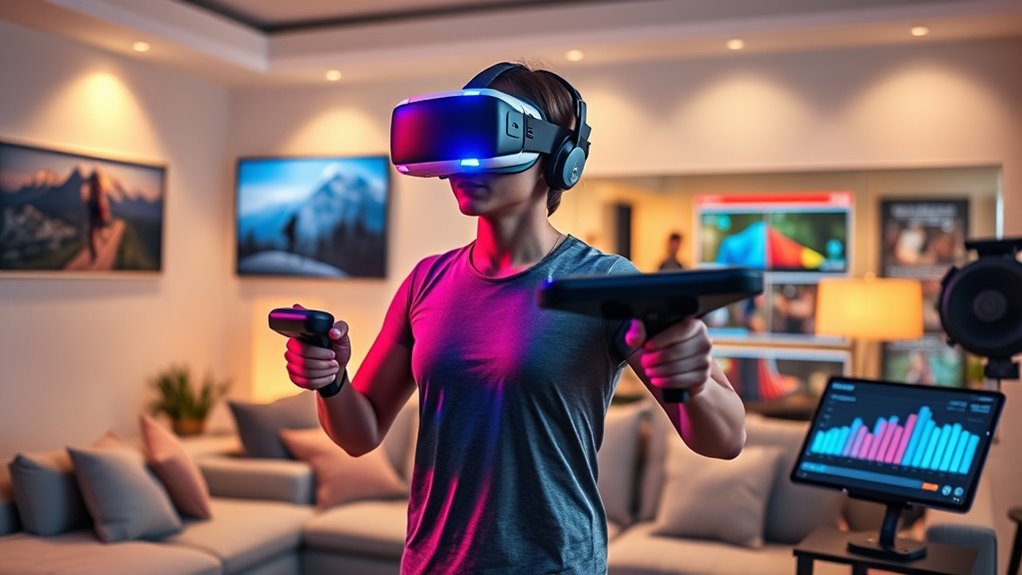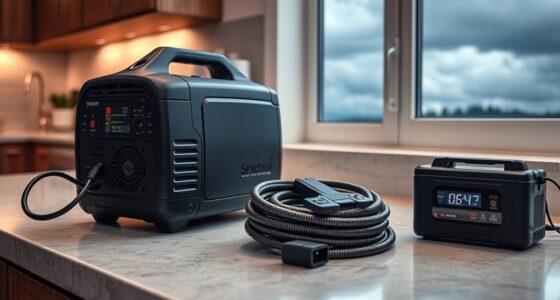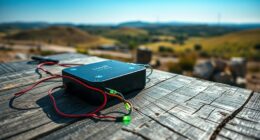To design a weekly VR fitness routine that hits your calorie goals, start by setting clear, realistic targets based on your current fitness level. Choose engaging, adjustable games like boxing, dancing, or rhythm challenges that match your desired intensity. Schedule varied sessions to prevent fatigue, including warm-ups and cool-downs, and track your progress to stay motivated. Regularly adjust your activities and intensity, and for more detailed strategies, there’s plenty to explore further.
Key Takeaways
- Define clear weekly calorie burn targets aligned with your fitness goals and adjust based on progress.
- Balance different VR activities (cardio, strength, flexibility) to optimize calorie expenditure and prevent routine fatigue.
- Incorporate warm-up and cool-down routines to enhance safety and recovery during workout sessions.
- Monitor your performance and calorie data regularly, increasing intensity or duration as your fitness improves.
- Schedule rest days and mix in other physical activities to prevent overtraining and promote sustainable progress.
Assessing Your Fitness Goals and VR Capabilities
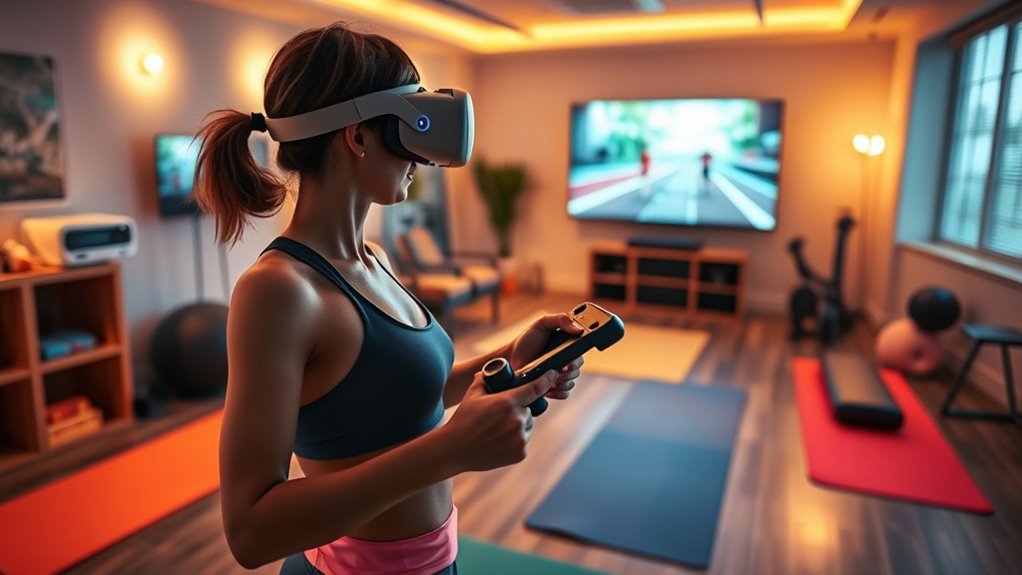
Before jumping into VR fitness, it’s important to clearly define your fitness goals and understand your VR capabilities. Ask yourself whether you’re aiming to lose weight, build strength, improve endurance, or just stay active. Setting specific, measurable goals helps you stay motivated and track progress. Next, assess your VR hardware and software. Are your controllers and sensors accurate? Is your play space large enough for safe movement? Knowing your VR setup’s limits guarantees you select suitable activities that match your fitness level. Be honest about your current fitness status and any health issues. This awareness helps you choose appropriate intensity levels and avoid injury. Taking these steps creates a solid foundation for building an effective, enjoyable VR fitness routine tailored to your needs. Additionally, understanding projector capabilities such as refresh rates and tracking precision can enhance your overall VR experience and safety.
Choosing the Right VR Fitness Games and Experiences
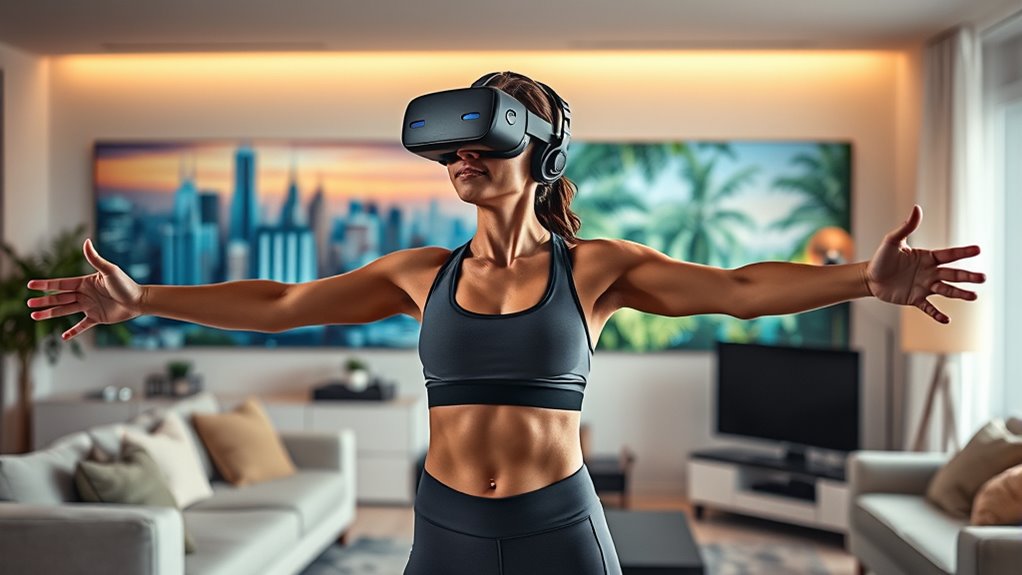
Selecting the right VR fitness games and experiences is essential to staying motivated and making progress toward your goals. You want options that challenge you without overwhelming you, keeping workouts engaging. Consider games that match your fitness level and favorite activities—whether it’s boxing, dancing, or rhythm-based exercises. Look for experiences with adjustable difficulty to progress gradually. Here’s a quick comparison:
| Game Type | Intensity Level | Fun Factor |
|---|---|---|
| Rhythm Games | Moderate | High, keeps you moving |
| Boxing Simulations | High | Very engaging, high burn |
| Dance Programs | Moderate to High | Energetic and enjoyable |
| Adventure Games | Varies | Keeps you curious and active |
Choosing games that align with your interests and goals for consistent, enjoyable workouts can help you stay committed and see better results. Incorporating exercise variety can prevent boredom and improve overall fitness.
Structuring Your Weekly Workout Schedule
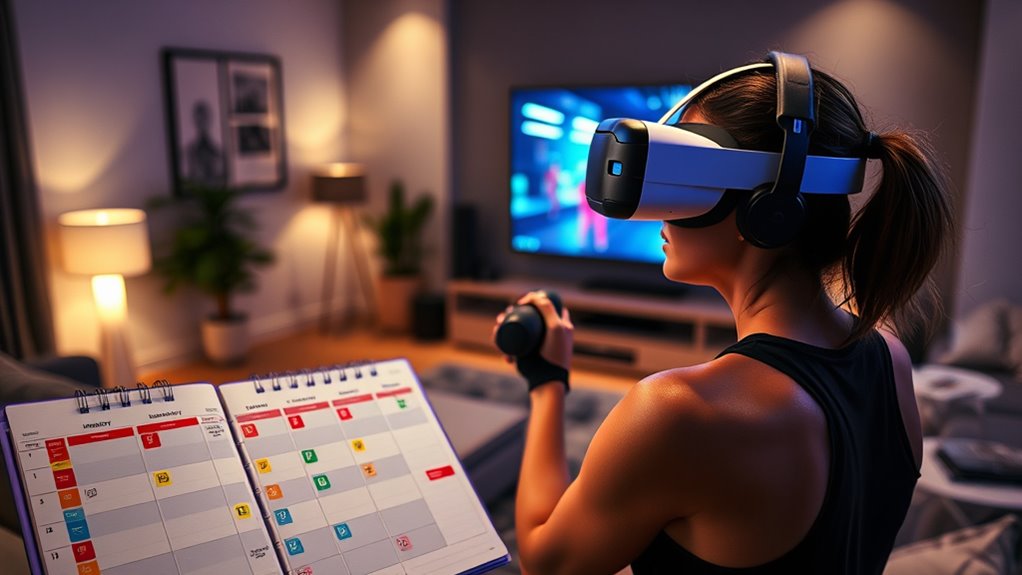
To keep your VR fitness routine effective, you need to balance different types of workouts and activities. Setting realistic goals helps you stay motivated and track progress without feeling overwhelmed. By planning your week thoughtfully, you can maximize results and prevent burnout. Regularly reviewing and adjusting goals ensures your routine remains aligned with your evolving fitness level and needs.
Balance Workout Variety
Creating a balanced VR fitness routine means mixing different types of workouts throughout the week to prevent plateaus and keep motivation high. Variety not only challenges different muscle groups but also keeps your sessions exciting. To achieve this, consider incorporating:
- Cardio-focused sessions like virtual running or cycling to boost endurance.
- Strength workouts such as bodyweight exercises or weightlifting VR games to build muscle.
- Flexibility or balance routines like yoga or stretching apps to improve recovery and prevent injury.
Alternating these types guarantees you’re targeting different fitness components and staying engaged. You’ll avoid burnout and promote overall progress. Remember to listen to your body and vary intensity levels to maintain consistency and enjoyment. A diverse routine keeps your workouts fresh and helps you reach your calorie goals effectively. Additionally, incorporating variety in workout types can enhance motivation and prevent boredom over time.
Set Realistic Targets
Designing a weekly VR fitness schedule with realistic targets helps you stay consistent and motivated. Set achievable goals based on your current fitness level and available time. Don’t aim for too much at once, as this can lead to burnout or frustration. Break your weekly calorie or activity goals into manageable daily targets, making progress feel attainable. Track your performance and adjust targets as needed to stay challenged but not overwhelmed. Remember, regular music sessions and consistent routines build habits and prevent injury. Be honest with yourself about what you can sustain long-term. By setting realistic, clear targets, you’ll maintain motivation, see steady progress, and make VR fitness a sustainable part of your routine.
Incorporating Warm-Ups and Cool-Downs in VR Sessions

Starting your VR workout with a warm-up helps prevent injuries and prepares your muscles for activity. After your session, effective cool-downs relax your body and reduce soreness. Always prioritize safe stretches to protect yourself and maximize your recovery. Incorporating gentle stretching exercises before and after your workout can further improve flexibility and reduce muscle tension.
Warm-Up Importance
Since VR fitness sessions involve dynamic movements and immersive experiences, incorporating warm-ups and cool-downs is essential to prevent injuries and enhance performance. A proper warm-up prepares your muscles and joints, reducing strain during intense activity. It also increases blood flow, helping you stay energized. Essential oils such as lavender or peppermint can be used during warm-ups to enhance relaxation and alertness. Here are three reasons why warm-ups matter: 1. They loosen stiff muscles, minimizing the risk of strains. 2. They gradually elevate your heart rate for sustained energy. 3. They improve your focus and coordination for better gameplay. Skipping this step can lead to soreness or injuries, which might sideline your workout. Taking a few minutes to warm-up ensures your body is ready for the demands of VR exercises, making your sessions safer and more effective.
Effective Cool-Downs
To maximize the benefits of your VR fitness sessions and prevent post-workout soreness, incorporating a proper cool-down is just as important as warming up. After your main workout, gradually reduce your activity intensity to help your heart rate and breathing return to normal. Incorporate gentle movements like slow stretching, deep breathing, or light arm swings to ease muscle tension. This helps prevent blood pooling in your limbs and reduces stiffness. Staying in the cool-down phase for 5-10 minutes, focusing on controlled breathing and relaxed movements. Additionally, using fabric decorating markers can be a fun way to personalize your recovery gear or workout accessories. Remember, a proper cool-down not only aids recovery but also prepares your body for future sessions. Consistently including this step ensures you maximize results and stay injury-free.
Safety in Stretches
In VR fitness sessions, incorporating proper warm-ups and cool-downs is essential to guarantee safety and prevent injuries. When stretching in VR, always start gently to avoid overstretching or straining muscles. Proper stretches improve flexibility and prepare your body for activity, reducing injury risk.
Here are three safety tips:
- Ease into stretches slowly, avoiding sudden movements.
- Listen to your body—stop if you feel pain or discomfort.
- Hold stretches for 15-30 seconds, not bouncing or forcing movements.
Tracking Progress and Adjusting Intensity

Tracking your progress in VR fitness helps you stay motivated and guarantees you’re meeting your goals. Use the built-in stats and feedback features of your VR app to monitor your calorie burn, workout duration, and intensity levels regularly. Keep a journal or digital log to note your achievements and any challenges you face. If you notice your calorie burn decreasing or your workouts feeling easier, it’s time to increase intensity—add more movement, extend session length, or try a more challenging game mode. Additionally, paying attention to performance metrics can help you identify patterns and areas for improvement. Conversely, if you’re overly exhausted or not hitting your targets, scale back slightly to prevent burnout. Consistently adjusting your effort ensures steady progress, keeps workouts engaging, and helps you reach your weekly calorie goals efficiently.
Balancing VR Workouts With Other Physical Activities
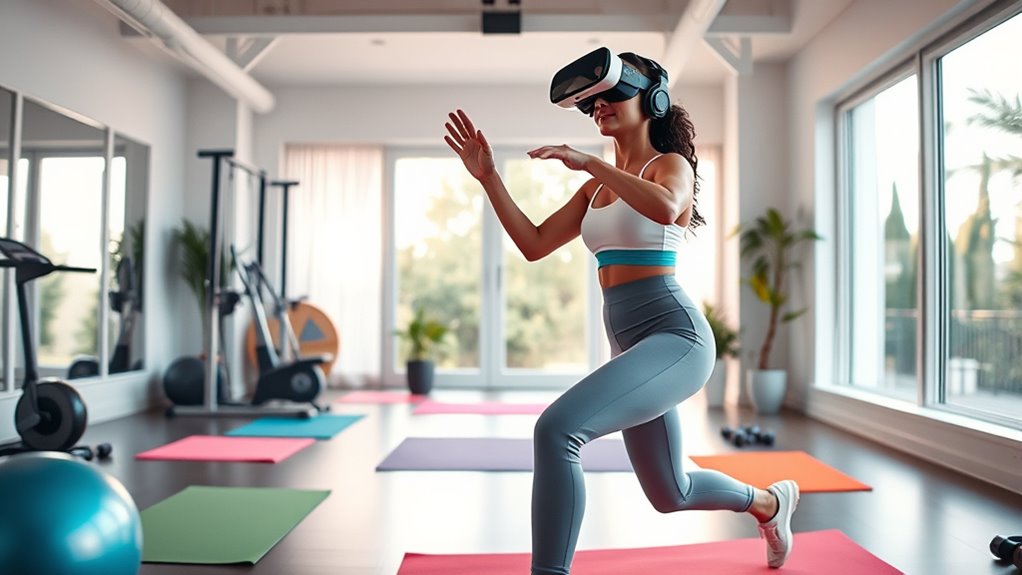
While VR workouts are engaging and effective, balancing them with other physical activities guarantees a well-rounded fitness routine. Incorporating different types of exercise helps prevent overuse injuries and keeps your motivation high. Here are some ways to strike that balance:
- Schedule cardio sessions like jogging or cycling on non-VR days to boost endurance.
- Include strength training or bodyweight exercises to build muscle and support your VR activities.
- Practice flexibility or yoga to improve mobility and prevent stiffness from intense VR sessions.
- Understanding proper toilet maintenance and avoiding common issues can ensure your environment stays hygienic and functioning well, supporting your overall health and fitness goals.
Mixing these activities ensures you target all fitness components, avoid burnout, and stay motivated. Remember, variety keeps your routine fresh and helps you reach your calorie goals more efficiently.
Tips for Staying Motivated and Consistent
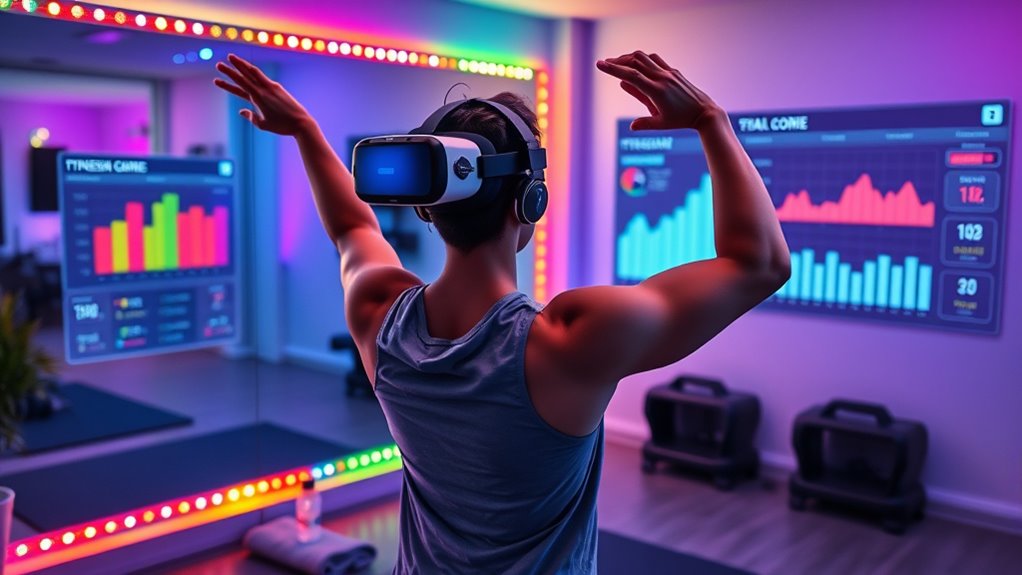
Staying motivated and consistent with your VR fitness routine can be challenging, but setting clear goals and tracking your progress makes a big difference. Define specific, achievable targets, like weekly calorie burn or workout frequency, to keep yourself focused. Use a journal or app to record your sessions, so you see your improvements over time. Mix up your workouts to prevent boredom—try different games or intensity levels. Reward yourself for milestones to boost motivation. Find a workout buddy or join online communities for accountability. Remember, consistency is key; even on days you’re less motivated, doing a shorter session is better than skipping entirely. Keep your routine enjoyable and remind yourself of your fitness goals to stay committed long-term.
Frequently Asked Questions
How Can I Prevent Vr-Induced Motion Sickness During Workouts?
You can prevent VR-induced motion sickness during workouts by taking simple steps. Start with shorter sessions, gradually increasing duration as you get comfortable. guarantee your play area is well-ventilated and free of distractions. Adjust the VR headset for a snug fit and set the visuals to lower motion intensity if possible. Take regular breaks, stay hydrated, and listen to your body—stop if you feel dizzy or nauseous.
What Safety Precautions Should I Take During VR Fitness Sessions?
Think of your VR fitness session as a delicate dance with technology — safety is your guiding rhythm. Keep your play area clear of obstacles, wear comfortable gear, and stay seated if needed. Take regular breaks to avoid fatigue and hydrate often. Listen to your body’s signals; if something feels off, pause and reassess. These precautions guarantee your workout remains a safe, exhilarating journey, not a stumble.
Can VR Fitness Help Improve Specific Athletic Skills?
VR fitness can help improve specific athletic skills by providing immersive, targeted training experiences. You can practice agility, balance, and coordination in realistic scenarios, which translate to real-world improvements. Many VR platforms offer skill-specific exercises tailored to sports like tennis, boxing, or soccer. By regularly engaging with these tailored routines, you enhance muscle memory, reaction time, and technique, ultimately boosting your athletic performance effectively and efficiently.
How Do I Integrate VR Workouts With Traditional Gym Routines?
Did you know that combining VR workouts with traditional gym routines increases overall activity levels by 30%? To integrate effectively, schedule VR sessions for cardio or fun variety on alternate days, complementing strength training at the gym. Use VR for engaging warm-ups or cool-downs, ensuring a balanced routine. This mix keeps you motivated, improves endurance, and maximizes your fitness results without feeling repetitive or overwhelming.
Are There Recommended Recovery Strategies After Intense VR Sessions?
After intense VR sessions, you should prioritize recovery to prevent injury and improve performance. You might try gentle stretching to ease muscle tension, stay hydrated to replenish lost fluids, and get plenty of sleep for muscle repair. Incorporate light activity like walking or yoga to keep blood flowing. Listen to your body—if you feel sore, give yourself extra rest days. These strategies will help you recover effectively and stay consistent.
Conclusion
Now that you have a solid plan, sticking to your VR fitness routine is like tending a garden—you’ll see your efforts grow stronger and more vibrant over time. Keep your goals clear, stay motivated, and listen to your body. With consistency, your workouts will become as natural as breathing, and you’ll hit those calorie targets with confidence. Remember, every step forward is a victory on your fitness journey.
